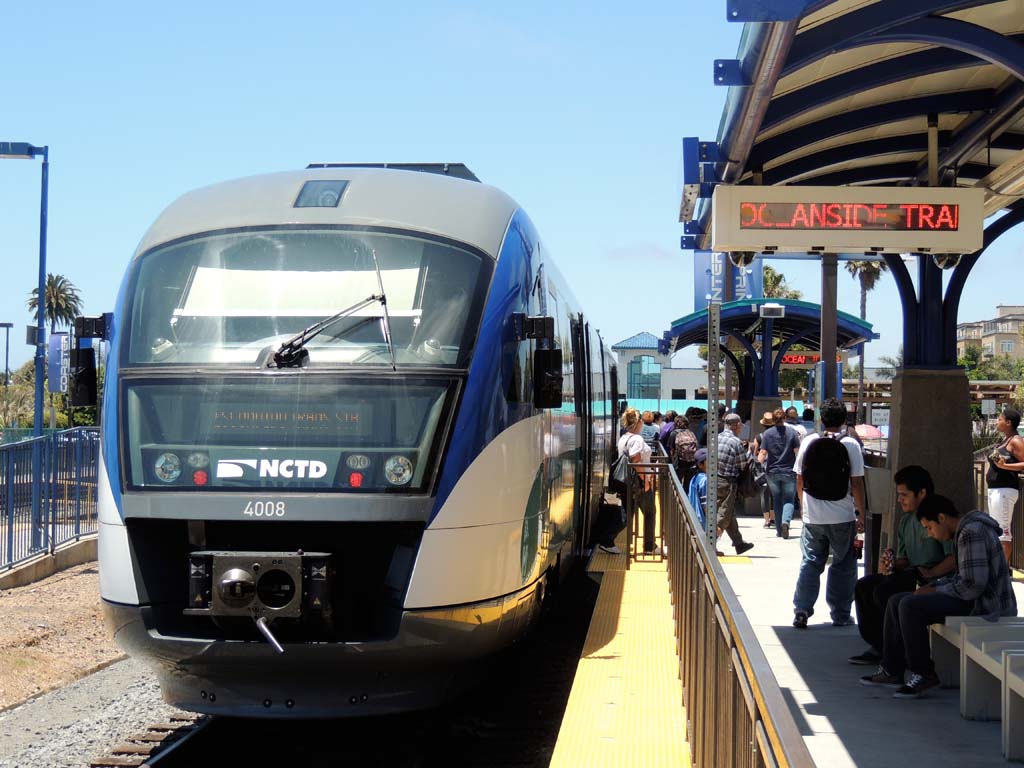OCEANSIDE — The San Diego Association of Governments (SANDAG) and North County Transit District (NCTD) are partnering together to expand the Oceanside Transit Center’s train capacity as early as next year.
With rail service originating in the city back in 1882, today more than 1.2 million passengers travel through the Oceanside Transit Center each year, and 134 trains pass through the center each weekday, according to SANDAG.
The current Transit Center bustles with NCTD coaster commuter trains, Sprinter light rail trains, Amtrak Pacific Surfliner trains, Metrolink Commuter trains, and BNSF Railway freight trains, along with Breeze buses, Riverside Transit Authority buses, and privately run buses, including Greyhound.
With the Center’s current capacity, only two trains can board simultaneously, requiring all other trains to idle outside of the station until a rail and/or platform becomes available.
SANDAG and NCTD intend to change that by building a new 1,000-foot long boarding platform and a third train track.
The expansion, which would extend from Wisconsin Avenue to the station, would enable Coaster, Metrolink, and Amtrak Pacific Surfliner trains to board at the same time, according to SANDAG. It would also allow trains to move through the station while two trains are boarding.
The changes have the potential to support more timely transportation service and more frequent service.
Furthermore, the project expands the Center’s capacity to host more trains and trains with more cars, though the transportation services do not have plans to add more trains in the near future.
“The immediate impact (of the project) is operational flexibility, and the long term is that we can have more trains,” explained NCTD Civil Engineer Cyril Rajan.
“We think this project is really vital to the city of Oceanside,” said SANDAG senior transportation Engineer Dean Hiatt while presenting the project to MainStreet Oceanside on Tuesday.
He said that the improvements would ideally bring more people and therefore more business to Oceanside as well as reduce cars traveling along Interstate 5.
Board members of MainStreet Oceanside, an association of businesses in downtown Oceanside, expressed concern about the current noise levels from train horns and the potential for additional noise if more trains are added, particularly given the hotels that are being constructed along the rail corridor.
Hiatt explained that establishing quiet zones is the city’s responsibility. The city would need to make safety improvements to railroad crossings before a quiet zone, a rail crossing where trains would not be required to blow their horns, could be established.
Board members voiced frustration when they learned that these safety improvements would also have to be paid for by the city with no help from SANDAG or NCTD.
Despite this, the board voted to support the project given its potential to bring more business to downtown.
Final engineering work on the Oceanside Transit Center Improvement Project is being completed, and construction is anticipated to begin in 2014.
Hiatt explained that SANDAG is currently working through remaining issues, including leveling the platforms to meet federal ADA requirements, before a construction date can be established.
Construction of the project should take about 13 to 14 months.
SANDAG will do “everything it can” to avoid disrupting service at the Center during construction, said Hiatt.
But Rajan acknowledged that the project could cause some weekend service disruptions.
The total project is estimated to cost $19.5 million. TransNet has provided $16.1 million, the regional half-cent sales tax, and SANDAG has provided the remaining $3.4 million from federal American Recovery and Reinvestment Act funds.
The Oceanside Transit Center Improvement Project is part of SANDAG’s efforts to enhance San Diego County portions of the Los Angeles-San Diego-San Louis Obispo (LOSSAN) Corridor over the next 40 years.
One of SANDAG’s major projects includes double tracking more than 97 percent of the LOSSAN Corridor in San Diego County by 2050. Currently, only half of this portion of the track is double tracked.
Visit KeepSanDiegoMoving.com/OTC for more information.

